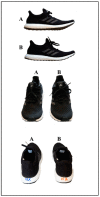The Impact of Grounding in Running Shoes on Indices of Performance in Elite Competitive Athletes
- PMID: 35162340
- PMCID: PMC8834746
- DOI: 10.3390/ijerph19031317
The Impact of Grounding in Running Shoes on Indices of Performance in Elite Competitive Athletes
Abstract
The introduction of carbon fiber plate shoes has triggered a plethora of world records in running, which has encouraged shoe industries to produce novel shoe designs to enhance running performance, including shoes containing conductor elements or "grounding shoes" (GS), which could potentially reduce the energy cost of running. The aim of this study was to examine the physiological and perceptual responses of athletes subjected to grounding shoes during running. Ten elite runners were recruited. Firstly, the athletes performed an incremental running test for VO2max and anaerobic threshold (AT) determination, and were familiarized with the two shoe conditions (traditional training shoe (TTS) and GS, the latter containing a conductor element under the insole). One week apart, athletes performed running economy tests (20 min run at 80% of the AT) on a 400 m dirt track, with shoe conditions randomized. VO2, heart rate, lactate, and perceived fatigue were registered throughout the experiment. No differences in any of the physiological or perceptual variables were identified between shoe conditions, with an equal running economy in both TTS and GS (51.1 ± 4.2 vs. 50.9 ± 5.1 mL kg-1 min-1, respectively). Our results suggest that a grounding stimulus does not improve the energy cost of running, or the physiological/perceptual responses of elite athletes.
Keywords: earthing; environmental physiology; grounding; running economy; running performance; shoe technology.
Conflict of interest statement
M.K., T.B., M.G., D.R. are employees of adidas AG. B.M.P., I.Z., A.G.A., J.A.C., Y.P.P. have no conflicts of interest relevant to the content of this article.
Figures




Similar articles
-
A Randomized Crossover Study Investigating the Running Economy of Highly-Trained Male and Female Distance Runners in Marathon Racing Shoes versus Track Spikes.Sports Med. 2019 Feb;49(2):331-342. doi: 10.1007/s40279-018-1012-3. Sports Med. 2019. PMID: 30374945 Clinical Trial.
-
Recent Improvements in Marathon Run Times Are Likely Technological, Not Physiological.Sports Med. 2021 Mar;51(3):371-378. doi: 10.1007/s40279-020-01420-7. Epub 2021 Jan 13. Sports Med. 2021. PMID: 33442838 Free PMC article.
-
Effects of the Nike ZoomX Vaporfly Next% 2 shoe on long-interval training performance, kinematics, neuromuscular parameters, running power and fatigue.Eur J Sport Sci. 2023 Jul;23(7):1315-1323. doi: 10.1080/17461391.2023.2171907. Epub 2023 Feb 23. Eur J Sport Sci. 2023. PMID: 36680410
-
Variability in Running Economy of Kenyan World-Class and European Amateur Male Runners with Advanced Footwear Running Technology: Experimental and Meta-analysis Results.Sports Med. 2023 Jun;53(6):1255-1271. doi: 10.1007/s40279-023-01816-1. Epub 2023 Mar 2. Sports Med. 2023. PMID: 36862339 Free PMC article.
-
The energetics of running and running shoes.J Biomech. 1993;26 Suppl 1:41-51. doi: 10.1016/0021-9290(93)90078-s. J Biomech. 1993. PMID: 8505351 Review.
Cited by
-
Grounding (earthing) as related to electromagnetic hygiene: An integrative review.Biomed J. 2023 Feb;46(1):30-40. doi: 10.1016/j.bj.2022.11.005. Epub 2022 Dec 7. Biomed J. 2023. PMID: 36496151 Free PMC article. Review.
References
Publication types
MeSH terms
Substances
LinkOut - more resources
Full Text Sources
Miscellaneous

